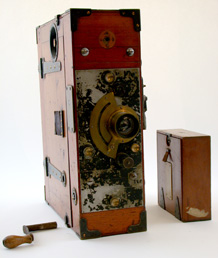
The camera is in the collection of the Bill Douglas Cinema Museum at the University of Exeter
Camera which captured the Battle of the Somme on display
A camera which is thought to have shot the first war film will be on display at a special exhibition to mark the centenary of the Battle of the Somme.
Experts believe it is likely that the Moy-Bastie camera was used to shoot the famous film The Battle of the Somme, which was seen by an estimated 20 million people.
The film and camera will both be on show to mark 100 years since the start of the World War One battle.
The camera is in the collection of the Bill Douglas Cinema Museum at the University of Exeter but has been loaned to the Imperial War Museum for their exhibition Real to Reel: A Century of War Movies, which is running from 1 July to January.
The camera is signed inside one of the magazines by the great wartime cameraman J.B McDowell, who filmed some of the combat sequences that make up the film.
The Battle of the Somme was filmed by McDowell and Geoffrey Malins, using both authentic battlefield shots and, in some cases, scenes recreated for the cameras. It was released in Britain in August 1916, while the battle was still raging.
To mark the centenary the original Battle of the Somme film is being reissued by the Imperial War Museum around the United Kingdom with a new score by Devon composer Laura Rossi. It will be shown at the Royal Albert Memorial Museum and Art Gallery in early July.
Dr Phil Wickham, the curator of the Bill Douglas Cinema Museum, said: “The centenary of this battle, still a defining moment in British history, is an occasion to remember the power of the war film, both documentary and fictional. Real to Reel: A Century of War Moves tracks its development over the last century.
“The camera is not just a fascinating object in itself but represents a vital moment in our history.
“The Bill Douglas Cinema Museum is proud to be part of Real to Reel: A Century of War Movies and to give audiences visiting the Imperial War Museum a chance to see some of the treasures of our collections on the history of the moving image.”
Other Bill Douglas Cinema Museum artefacts loaned to the Imperial War Museum are a number of items relating to films from The Dam Busters and Oh! What a Lovely War.
The Moy-Bastie camera was acquired at auction by filmmaker Bill Douglas, whose collection makes up a large part of the museum’s collection, and his friend Peter Jewell in the 1980s. Bill and Peter then discovered McDowell’s signature inside its mechanism.
The Bill Douglas Cinema Museum has 75,000 objects connected with the moving image. Entry is free and it is open every day. Visit the Bill Douglas Cinema website.
Date: 30 June 2016